(单词翻译:单击)
It was Paul Cézanne who went to L'Estaque first, in 1864. He escaped the gray dreariness of Paris and later avoided army conscription in the Franco - Prussian War of 1870 in this sunny shorefront village outside Marseille. From the windows of a rented house next to the little church on the hill, he could look out on the tile rooftops leading down to the harbor, with its fishing boats, and across the wide bay to Marseille, the low, rocky mountains at its back.
1864年,保罗·塞尚(Paul Cézanne)初次来到埃斯塔克。他逃离了巴黎灰色的倦意,后来又逃过1870年法俄战争的部队征兵,来到马赛郊外这座阳光明媚的海滨渔村。坐在山上小教堂边一间租来的小屋里望向窗外,他能看见连绵的瓦片直通海港。浩淼的马赛港内渔船往来,背后是低矮的岩石山丘。
He painted intensely. With every brush stroke and every year, the landscape changed, the picture plane began to dissolve — the rooftops, the sea, the barren rocks, the forest-green scrub, all becoming new versions of themselves, transformed by his vision. “It's like a playing card. Red roofs against a blue sea,” Cézanne wrote of L'Estaque to his friend the painter Camille Pissarro in an 1876 letter. “There are olive trees and pines that always keep their leaves. The sun is so frightful that it seems as if all the objects are reduced to silhouette, not only in black and white, but in blue, in red, in brown, in violet.”
他充满激情地画着。一笔笔,一年年,风景渐次改变,画面逐日融合。屋顶、海水、荒芜的岩石、青翠的灌木丛,在他的视野中幻化为独特的新模样。“就像打牌。红屋顶对蓝海洋。”塞尚在1876年写给朋友、画家卡米耶·毕沙罗(Camille Pissarro)的信中这样描述埃斯塔克,“橄榄树和松树四季长青。阳光如此耀眼,万物似乎只剩剪影,却又不是黑白两色,而是蓝色、红色、棕色、紫色的。”
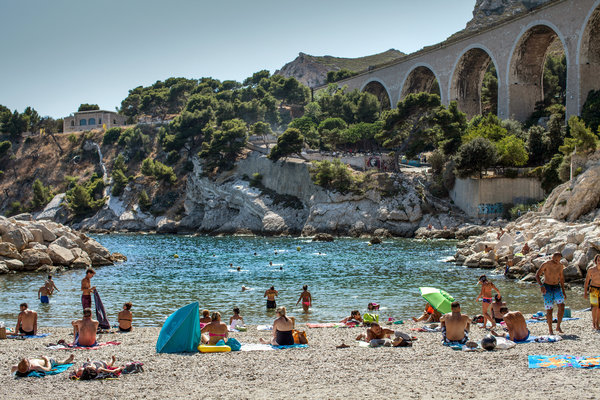
In 1906, Georges Braque went to L'Estaque after seeing Cézanne's work on view in Paris. He stayed five months. “It was in the South that I felt my rapture rise in me,” wrote Braque, who grew up in Le Havre, on the English Channel. That same fall, Cézanne died. One century was giving way to the next. Braque had reshuffled the playing cards, making the familiar landscape even more unfamiliar. With his brush, the boxy roofs became puzzle pieces, the arches of the local viaduct a study in the contrast between positive and negative space. By 1908, he had flattened the windswept trees to the boundary between the second and third dimensions. Impressionism changed to Fauvism in Braque's hallucinatory forests, where solitary walkers lose themselves in oneiric expanses of yellow and purple — and then to Cubism.
1906年,乔治·布拉克(Georges Braque)在巴黎观赏了塞尚的风景画之后追随而来,在埃斯塔克住了五个月。“到了南部,一阵狂喜油然而生,”布拉克写道。他童年成长于英吉利海峡边的法国港市勒阿弗尔。就在那个秋天,塞尚死了,于是一个世纪让位另一个世纪。布拉克重新洗牌之后,本已熟悉的风景更加陌生。在他的画笔下,四方的屋顶都变成了拼图的碎片,在正副两种空间的对照之下,当地高架桥的拱门成为独特的杰作。到了1908年,他的画笔抚平了轻风拂过的树林,模糊了二维与三维的界限。在布拉克幻觉的森林里,印象派变成了野兽派,孤独的行者迷失在黄色与紫色的茫茫大梦中。立体主义随之而来。
I wanted to see it for myself, this landscape of L'Estaque that I had known from so many paintings over the years, and that I had rediscovered in the Musée d'Orsay and the Pompidou Center since moving to Paris last year. And so, one weekend this spring, I took a train to Marseille to look around. The sun was bright, but I was in a ruminative mood. My own picture plane was starting to shift. I wanted new vistas. I wanted, I think, to step into a painting.
我想亲眼见识这埃斯塔克的风景。多年来,我在许多绘画中见过。去年搬家到巴黎,在奥赛美术馆和蓬皮杜艺术中心再次得见。于是,今年春天的一个周末,我搭火车来到马赛观光。阳光灿烂,我却若有所思。画面在切换。我想见到全新的风景,期待自己踏入一幅画卷。
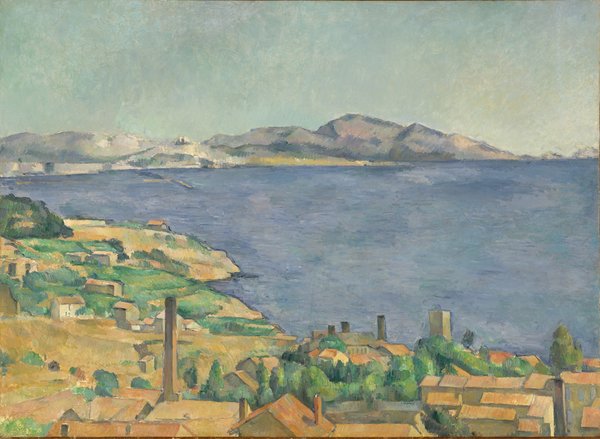
But scenes change over time. While van Gogh's Arles maintains much of its postcard perfection, and Monet's gardens at Giverny theirs, L'Estaque, in spite of its significance in art history, is perhaps the least touristic and least romanticized of the locales that so inspired the great French painters. Today, L'Estaque is not the sleepy fishing village that Cézanne and Braque found more than a century ago. It is part of the 16th Arrondissement of vivacious Marseille, a working-class area absorbed into the busy larger city, with a pretty harbor, one main street lined with shops and cafes, and a dearth of parking. I was glad to be there anyway. After all, what is travel — or life, for that matter — but a continuing negotiation between expectation and reality?
但是景物已经在光阴中更改。梵高(van Gogh)笔下的阿尔勒和莫奈(Monet)笔下吉维尼小镇的花园如实展现了明信片般的美景,而埃斯塔克呢,尽管在艺术史上地位显赫,启迪了许多法国艺术家的创作灵感,却恐怕是附近最不适合旅游,也毫不浪漫的地方。今天,埃斯塔克不再是一百多年前塞尚和布拉克眼中郁闷的小渔村,从16世纪起,这个工人阶级聚居地就是生机勃勃的马赛郡的一部分,最终划入了繁忙的大城市。这里有美丽的海港和一条主干道,街边都是店铺和餐厅,停车场远不够用。无论如何,我很高兴自己来到了那里。旅行或者人生究竟是什么?不就是期待与现实之间不断地调整吗?
A friend and I arrived at midday on a lazy Saturday. In the cafes by the harbor, people drank coffee or stirred glasses of cloudy yellow Pernod. There were market stalls with cheap socks, housewares and towels, and a flea market where women in abayas browsed for bargains. We settled into a waterfront restaurant and ate fish and got drowsy on dry rosé, watching boats bobbing in their moorings. Off a nearby dock, young boys, tanned and fearless, somersaulted off the rocks into the water, like so many of their kin around the Mediterranean, over so many centuries.
一个慵懒的周六中午,我和一个朋友来到了埃斯塔克。海港边的餐厅里,大家在喝咖啡,或者搅动玻璃杯中云雾般的黄色茴香酒。附近市场上有便宜袜子、家用器皿及毛巾出售。跳蚤市场里,身穿阿拉伯阿巴亚袍的妇女们搜寻着物美价廉的物品。我们走进一家海滨餐厅,吃了鱼肉,喝了粉红玫瑰酒,醉眼朦胧地看着门外一艘艘小船轻灵地泊入港口。附近一座码头边,麦色肌肤的青年英勇无畏,一个筋斗就翻进了水里,就像千百年来他们在地中海的亲戚们那样。
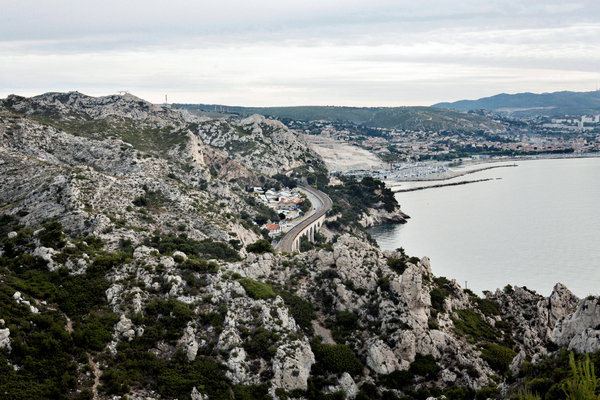
Up the hillside on the edge of town, the landscape opens up to a wide view of the harbor. You can see a small island, and the hills east of Marseille, bluish in the distance, just as they appear in so many of Cézanne's landscapes, “Gulf of Marseille Seen From L'Estaque,” which are now scattered in museums around the world. On a lookout point near the Fondation Monticelli, which celebrates Adolphe Monticelli, a lesser-known Marseille painter who died in 1886, a group of young men were drinking beer and having a makeshift barbecue. Their car radios played Arabic-inflected hip-hop. On the beach below, people were sunning themselves on the rocks.
小城边的山坡上视野开阔,可直接望见海港。你可以看到一座小岛,正如塞尚许多风景画展示的那样,马赛东部的山峦在远方幻化淡淡的蓝灰色,比如《从埃斯塔克一岚马赛湾》(Gulf of Marseille Seen From L'Estaque),而今,这些画作散落在世界各地的博物馆里。蒙蒂切利喷泉附近的观景台上,一群男青年一边喝啤酒,一边将就着烤肉,汽车电台播放着阿拉伯曲风的街舞音乐。这座喷泉是为了纪念一位不太知名的马赛画家阿道夫·蒙蒂切利(Adolphe Monticelli)而建的,他于1886年去世。在下方的海滩上,人们在岩石上晒着太阳。
When Cézanne was here, there were no doubt 19th-century locals also picnicking nearby. But the artist willfully left out the quotidian, the bustling harbor, instead shaping the landscape to his own imaginative needs. “I have a lot of good points of view, but that doesn't exactly add up to a theme,” Cézanne wrote of L'Estaque to his friend émile Zola in a letter. It was Cézanne's mother who had first taken a house in L'Estaque in the summer of 1864, when the painter was 25. Later, in 1870, he hid out here to avoid army conscription, and also to hide the existence of his partner, Marie-Hortense Fiquet, from his father, who disapproved. One wonders how the course of art history might have turned out had Cézanne's mother chosen a house in a different town.
毫无疑问,19世纪塞尚寄居此地时,本地人也在附近野餐。但是这位艺术家任性地抛弃了写实的生活琐事和熙熙攘攘的港口,反而让风景在笔下迎合自己的想像需求。“我有许多好观点,却无法构成一个主题。”塞尚在给朋友爱弥儿·左拉(émile Zola)的信中如此描述埃斯塔克。1864年,塞尚25岁那年,他的母亲在埃斯塔克买了一座房子,后来到了1870年,他隐居于此,不仅为逃避兵役,也背着父亲,悄悄带来了自己的情妇玛丽·浩特思·菲凯(Marie-Hortense Fiquet),因为父亲不赞成他俩交往。人们很想知道,假如塞尚的母亲在另一座小镇买房,艺术史的走向是否会由此改写?

or artists who found their way here, the village was a place of refuge, but also a place of nostalgia. In 1877, Zola spent time here, escaping the polemics directed against his novel “L'Assommoir,” about a working-class alcoholic. “The country is superb,” he wrote in a letter that year. “You might find it arid and desolate, but I was brought up on these exposed rocks and these bare moors, so I am moved to tears when I see them again. The smell of the pines alone brings back my youth.” While there, Zola wrote a short story, “Na?s Micoulin,” about a hunchback who works in a local factory, which Marcel Pagnol adapted into his 1945 film, “Na?s.”
对于在此找到出路的艺术家们,这座渔村是避世之土,也是怀旧之乡。1877年,左拉(Zola)来到这里,借以逃离世人对他的工人阶级酒鬼主题小说《小酒店》(L'Assommoir)的非议。“这片乡村非常好,”那年他在信中写道。“你或许会嫌它干旱荒芜,但我就在这裸露的岩石和荒野中长大,所以,再次见到这一切时,我竟流泪了。仅仅是松树的气息,就让我瞬间回到年轻时代。”左拉在这里创作了短篇小说《纳伊斯·米库兰》(Na?s Micoulin)。它记述了本地一名驼背工人的故事,1945年,剧作家马塞尔·帕尼奥尔(Marcel Pagnol)将它改编为一部电影——《纳伊斯》(Na?s)。
In 1882, Pierre-Auguste Renoir came to visit Cézanne, and the two painted together. Renoir's “Rocky Crags at L'Estaque” of that year shows the hillside and vegetation in his characteristically fuzzy style. Cézanne always stayed more angular, more intense. He painted like a man working out a mathematical problem. Each brush stroke, each painting, reveals how he reached his conclusions. Every painter had a different perspective. In 1908, Raoul Dufy arrived to paint with his friend Braque, after seeing Braque's L'Estaque works displayed in Paris. The Fauvist André Derain painted colorful, happy harbor scenes that make Cézanne's look melancholy in comparison.
1882年,皮埃尔·奥古斯特·雷诺阿(Pierre-Auguste Renoir)来探访塞尚,二人携手作画。那一年,雷诺阿用他特色的朦胧画风在作品《埃斯塔克的峭壁》(Rocky Crags at L'Estaque)中刻画了此地的草木山川。塞尚总是更清瘦、更热烈,绘画时就像在孜孜不倦地解答数学难题。每一笔、每一幅画,都在揭示自己如何得出了结论。每一位画家都有独特的视角。1908年,劳尔·杜飞(Raoul Dufy)在巴黎看过朋友布拉克的杰作之后,与后者一起来到这里作画。野兽派画家安德烈·德兰(André Derain)再现了这里五光十色的快乐港口景象,相形之下,塞尚的作品顿显忧伤。
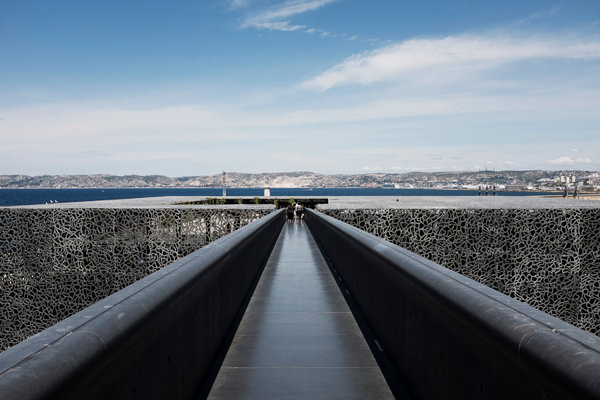
The best way to visit L'Estaque is as an afternoon or twilight jaunt, by boat, from Marseille, that great Mediterranean port city — Naples meets Barcelona — famous for its blinding light, its bouillabaisse, its couscous, its close ties to the Maghreb, and, alas, its often violent organized crime. Ferries to L'Estaque leave every hour from Marseille's Old Port, a deep harbor that has been in continuous use since the days of the ancient Greeks. The boat pulls out of the harbor and rounds the bend by the MuCEM — the Museum of European and Mediterranean Civilizations — a spectacular new space designed by Rudy Ricciotti, an architect based in nearby Bandol.
游览埃斯塔克的最佳方式是选个下午或黄昏,乘坐小船从伟大的地中海港口城市马赛来到这里徒步远游。这是那不勒斯与巴塞罗那相遇的地方。让它闻名遐迩的,有刺眼欲盲的强烈阳光,还有本地的浓香鱼汤、蒸麦粉,以及与非洲城市马格利布的密切纽带,哦!还有本地频繁的有组织犯罪。渡船每小时一趟,从马赛旧港出发,驶向埃斯塔克。旧港是一座偏僻的港湾,从古希腊时代就一直在使用。小船从港口出发,沿着欧洲及地中海文明博物馆(MuCEM)的曲线行驶。这座恢弘的新建筑是附近邦多尔的建筑师卢迪·瑞希奥提(Rudy Ricciotti)设计的。
Today, some of the best views of L'Estaque are from the roof of the MuCEM. With its dark cement latticework facade meant to evoke a casbah, the MuCEM is also a study in positive and negative space. (Mr. Ricciotti has said that in Marseille, the light is one of the strongest architectural elements.) From the top of an adjacent fortress, the MuCEM's roof stretches just below the line where the ocean meets the shore. In the foreground, a sparkling new tower by the architect Zaha Hadid swoops up into the air, reflecting the light and straddling the highway running west toward L'Estaque. Along that road, a billboard for Panzani Zakia halal lasagna fills the entire side of a tall building. Huge ferries bound for Tunisia and Algeria sit in the harbor.
而今,埃斯塔克最美的风景要从MuCEM的屋顶上领略。它阴暗的水泥网格正门让人想起阿拉伯城堡,同时,也是正副空间对照的杰作。(瑞希奥提先生在马赛说过,光线是最强大的建筑元素)从毗邻的城堡顶端望下去,MuCEM的屋顶就在海洋与海岸的交界线之下绵延。前景上,由建筑师扎哈·哈迪德(Zaha Hadid)设计的新楼拔地而起,灿烂夺目,横跨西行至埃斯塔克的公路。路边一块广告牌上是百珍妮扎奇娅(Panzani Zakia)的清真烤面,填满了这座高大建筑的整个侧面。驶向突尼斯和阿尔及利亚的巨大渡船在港口停泊。
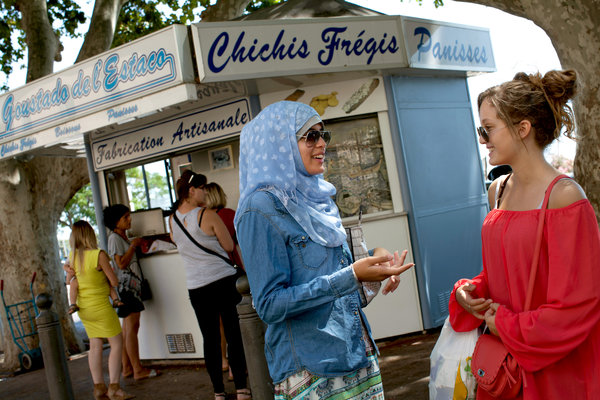
L'Estaque is only a 10-minute drive from downtown Marseille, and a half-hour trip by ferryboat, part of the city's transportation system. I did both, and I much preferred the boat. As it slowly neared the shore, I felt as if I were on the verge of entering a painting. One day, it was cloudy, and the dark sky against the pale rocky hills really did evoke a landscape by Cézanne. The viaduct painted by Braque stood out against the hillside. On the boat, I sat by a handful of local teenage girls with dark eyeliner, short skirts, fluorescent T-shirts and sneakers. They chatted more in Arabic than French and played with their cellphone ring tones. They were looking after a mischievous young boy with a balloon, which he popped gleefully as we reached the dock, startling me.
埃斯塔克距离马赛市中心只有10分钟的车程,然后再乘坐半小时的渡船。渡船是该市公共交通系统的一部分。公交车和船都坐过之后,我更喜欢坐船,因为当它渐渐接近海岸时,感觉自己恍然融入一幅画。一个多云的日子,黯淡的天空反衬着苍山隐隐,真让我记起塞尚的画中风光。布拉克笔下的高架桥耸立在山腰的背景之下。我坐在船上,身边一群本地少女画着黑眼线,穿着短裙、鲜艳的荧光T恤和运动鞋。她们用阿拉伯语而非法语谈笑,玩着手机铃声,照看着一个玩气球的淘气男孩。船刚抵达码头,男孩就兴高采烈地站起身,吓了我一跳。
My friend and I went to see the viaduct. Its tall arches were instantly recognizable from Braque's Cubist paintings. Someone had spray-painted the word “Orage,” or storm, in white bubble letters with black trim. There were rusted cars in the hills underneath it. The boxy houses now have satellite dishes on their roofs. One afternoon, we sat in a cafe in the harbor, where the sounds of bad Europop drifted over the water. Eventually, the waiter remembered us and brought cold drinks. Nearby, someone had spray-painted "Ne nous cultivez plus, on s'en charge," or "Don't educate us anymore, we'll take care of it," on a cement quai, where a yacht named for the writer André Malraux was docked. Mothers with headscarves watched their children frolic in the waterfront park.
我和朋友去看了高架桥。那高大的拱门可以在布拉克的立体主义画作中不断找到踪迹。有人用喷漆写下了“风暴”这个词,用的是白色的泡沫字体与黑边。低处的山峦上有陈旧的汽车。方方正正的房屋如今屋顶上已经安装了卫星接收天线。一天下午,我们坐在海港的一座餐厅里,欧洲流行(Europop)的糟糕音乐声从海上飘来。终于,服务员想起了我们,端来了冷饮。附近的水泥码头上,有人用喷漆写下了一行字:“别再教育我们了,我们自会照顾它。”一艘以作家安德烈·马尔罗(André Malraux)命名的游艇泊在港口。戴着头巾的母亲们看着孩子们在水滨公园里追逐打闹。
Kiosks on L'Estaque's main street sell local specialties: chichi frégi, fried dough with a hint of crushed black pepper inside and coated in coarse sugar, and panisses, chickpea flour fritters. We bought a snack and a cold bottle of La Cagole, a Marseille beer, and strolled up the quiet back streets. They were empty of people, except for a few other tourists hoping to walk in the footsteps of the great artists, and looking a bit disappointed. There were posters for the coming European parliamentary elections, for the Greens and the right-wing National Front, which would later triumph. We sat in the square by the church, by Cézanne's house, now marked by a small, unassuming plaque, and watched the sun set, turning the mountains behind Marseille a reddish pink. Some new buildings blocked the view of the harbor. Cranes rose high in the industrial port and the hulks of vast cruise ships lingered in the blue waters.
埃斯塔克大街上的售货亭供应各种本地特产:香酥炸糕,即炸面团里加少许压碎的黑椒粉,表面裹上粗糙的糖粒,还有鹰嘴豆馅的炸糕。我们买了点心和冰冷的马赛拉格高啤酒,漫步在僻静的小巷。四周空无一人,偶有若干游客本想追寻大艺术家的脚步,因而露出失望的神色。墙上贴着即将到来的欧洲议会大选的海报,支持绿党或右翼的国民阵线,后来后者赢了。我们坐在教堂边广场上看苍山落照,附近的塞尚旧居只用了一块低调的小标牌标示出来。夕阳将马赛城边的群山染成了一片绯红。新城挡住了视线,无法望见港口。起重机高高地矗立在工业港,庞大的游轮在蔚蓝的海面徘徊。
For years, Cézanne had ignored the parts of L'Estaque that he didn't want to paint. By 1885, he stopped coming. The landscape was changing too much for his taste, becoming too industrialized, with factories and chimneys cropping up along the shore. Economic development and artistic development subtly intertwined. Braque saw the factories, with their smokestacks spewing sodium and sulfuric acid, as source of inspiration. In 1910, he painted "Rio Tinto Factories at L'Estaque," a Cubist study in grays and browns that is now in the collection of the Pompidou Center.
多年来,塞尚对于埃斯塔克无法入画的片段视而不见。1885年之后,他没有再来。风景变得太多,不再符合他的品味。太工业化了。海岸上雨后春笋般冒出许多工厂和烟囱,经济发展和艺术发展微妙地纠缠。而布拉克见到工厂,目睹高大的烟囱喷出纳与硫酸气体,却找到了灵感的来源。1910年,他绘制了《埃斯塔克的力拓工厂》(Rio Tinto Factories at L'Estaque),这幅用灰色与棕色线条构成的立体主义杰作如今是蓬皮杜艺术中心的珍藏。
Cézanne moved elsewhere, to find new vistas. I remember that one spring, in my early 20s, I took the TGV from Avignon to Nice. Out the window, fields of lavender blurred by. And then, in the distance, there it was: Mont Ste.-Victoire. I already knew it by heart, the mountain Cézanne had painted so many times — a study in form, an exercise of style, a realm of the imagination. Not just a mountain, but the idea of a mountain. It was even more familiar out the windows of the fast train, the perspective ever changing. "Magnificent in the distance, meaningless closer up, mountains are but a surface standing on end," Joseph Brodsky wrote in "An Admonition," one of my favorite poems. Like Petrarch in the 14th century, who opened the door to the Renaissance and to new ways of thinking when he climbed Mont Ventoux simply to take in the view, Cézanne, by power of his vision, also changed forever the way we think and see.
塞尚去了别处寻找新的风景。记得我二十多岁时的一个春天,我乘坐巴黎至里昂的高速火车从阿维尼翁到尼斯。车窗外,薰衣草田飞驰而过,远处随之出现的是圣维多利亚山。我已经猜出来了。这座山,塞尚在他的作品中画过无数次,那是他对形状的研究,也是风格的练习与想像的国度。不仅是一座山,还是如山的理念。那在飞驰的火车窗外不断变换的,反而更为熟稔。透视角度无时无刻不在变幻。“山在远方甚是壮美,渐行渐近时反觉毫无意义,不过是平面竖着站起。”约瑟夫·布罗茨基(Joseph Brodsky)在他的诗作《告诫》中如是写道。这是我最爱的诗句之一。正如14世纪的彼得拉克(Petrarch) 攀登旺图山饱览山河,开启了文艺复兴的大门,开辟了崭新的思维方式,而塞尚,借助自己瑰丽的视野,也永远改变了我们思考与欣赏事物的方式。
At a monumental retrospective of paintings by Georges Braque at the Grand Palais in Paris that I saw last year, I found myself unexpectedly moved by some of the artist's late paintings, tiny landscapes from the mid-1950s, when he was in his 70s. His career had traced almost every new development in art for half a century, and then, nearing the end of his life, he returned to the beginning, to landscapes with rough brush strokes, more like van Gogh than Picasso. They seemed not just landscapes, but memories of landscapes.
去年,我在巴黎大皇宫观看不朽的乔治·布拉克作品回顾展,不期然被这位艺术家生前的一些作品感动了,那是他创作于20世纪50年代中期的若干小幅风景画。当时他已经七十多岁,在半个世纪的艺术生涯中,几乎经历了每个流派的发展,到了生命的暮年,却又回到了初心。他朴拙笔触下的风景更像梵高,而不是毕加索。那似乎不止是风景,更是对风景的记忆。
In the end, the L'Estaque of the artists may outshine the L'Estaque of life. But the place still lingers in my mind. I revisit the paintings in the museums. I think back to the weekend — to the sun, to the crusted sugar on the fried dough, to the ferries headed for the Maghreb, to the rocky coastline. The boat glides across the harbor toward the village. Marseille is at our back, the limestone hills approaching in the distance. There is a cool breeze. The ocean opens up before us. It is filled with possibility — and with the memory of possibility.
最后,埃斯塔克的艺术家或许让埃斯塔克的世俗生活相形见绌。但这个地方仍然在我的脑中徘徊,就再次到博物馆参观了他们的杰作。我的思绪回到了周末,那艳阳,那炸糕上酥脆的糖壳,那驶向马格利布的渡船,那崎岖的海岸线。小船滑过港湾,驶向渔村。马赛已抛在身后,远方石灰岩的小山渐行渐近。一阵清风吹来,大海在面前徐徐展开,洋溢着一切可能,一切纷纭的记忆。


